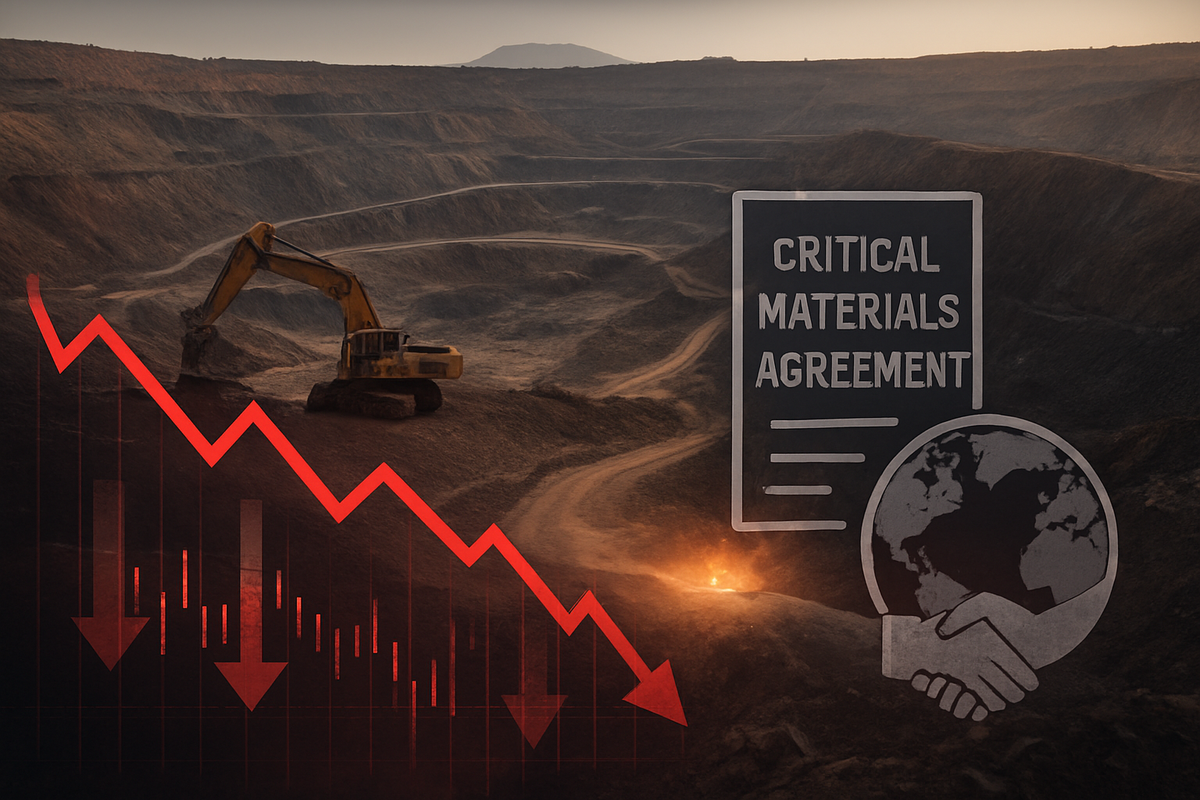
MP Materials (NYSE: MP), a leading player in the rare earth materials sector, experienced a sharp 12.1% decline in its stock price today, October 24, 2025. The significant sell-off comes on the heels of a recently inked critical materials agreement and growing investor speculation about an impending surge in rare earth supply. This market reaction highlights a delicate balance between national security interests in diversifying supply chains and the potential for market oversupply to impact commodity prices and, consequently, the profitability of key producers like MP Materials.
The downturn reflects a broader market recalibration, as investors digest the implications of new policy initiatives designed to secure critical mineral supplies. While such agreements are strategically vital, the immediate market sentiment suggests a concern that increased global output could dilute the pricing power of existing producers. Furthermore, the stock's substantial rally over the past year has left it with a valuation that many analysts deemed stretched, making it particularly vulnerable to profit-taking amidst shifting supply dynamics.
Critical Materials Agreement Fuels Market Jitters
The immediate catalyst for today's market movement was the critical minerals agreement signed on October 20, 2025, between President Donald Trump and Australian Prime Minister Anthony Albanese. This landmark framework outlines an ambitious $8.5 billion project pipeline and commits over $3 billion in critical mineral investments over the next six months. The primary objective is to bolster and diversify rare earth supply chains, reducing reliance on dominant foreign suppliers and enhancing economic security for both nations.
However, the positive long-term strategic implications of the agreement were overshadowed by specific commentary from President Trump, who stated, "In about a year from now, we'll have so much critical mineral and rare earths that you won't know what to do with them." This powerful statement ignited investor speculation, raising fears that a future oversupply of rare earths could significantly depress market prices. Such a scenario would directly impact the revenue and profitability of rare earth mining companies, including MP Materials (NYSE: MP), which operates the Mountain Pass mine in California. The market's tendency to "buy the rumor and sell the news" also played a role, as investors who had driven the stock higher on anticipation of such deals began to take profits once the agreement was formally announced.
Beyond the supply concerns, MP Materials' valuation has been a persistent point of contention. Prior to today's decline, the stock had surged by over 300% in the past year and nearly 400% year-to-date by October 2025. This meteoric rise left the company trading at 46.3 times sales, significantly above its five-year average price-to-sales ratio of 14.8. Similarly, its enterprise value to EBITDA (EV/EBITDA) stood at approximately 52 times, despite the company reporting negative cash flow. A discounted cash flow (DCF) analysis as of October 22, 2025, even suggested a potential overvaluation of over 3,000%, with an estimated intrinsic value of $2.36 per share against a market price of $74.11. These metrics, coupled with a price-to-book ratio of 14.2x compared to the US Metals and Mining industry average of 2.4x, signaled a significant premium and increased valuation risk, making the stock ripe for a correction.
Shifting Fortunes in the Rare Earth Landscape
The critical materials agreement and the ensuing supply speculation are poised to create both winners and losers across the rare earth landscape. Existing, high-cost producers or those with less diversified operations could face significant headwinds if rare earth prices fall due to increased supply. Companies primarily focused on upstream mining, like MP Materials (NYSE: MP), might see their margins squeezed, particularly if their processing capabilities are not yet fully integrated or optimized for lower price environments. Despite securing major agreements such as a $400 million Department of Defense partnership and a $500 million supply contract with Apple (NASDAQ: AAPL), concerns persist regarding potential delays and costs associated with building new facilities, with full magnet-grade separation and metallization capabilities not expected until 2028. This extended timeline leaves the company exposed to market volatility in the interim.
Conversely, companies involved in downstream processing, refining, or those with innovative technologies for rare earth extraction and separation could stand to benefit from a more abundant and potentially cheaper supply of raw materials. Manufacturers in sectors like electric vehicles, renewable energy, and defense, which rely heavily on rare earth magnets and components, could see reduced input costs, enhancing their profitability and competitiveness. For instance, companies like Tesla (NASDAQ: TSLA) or General Motors (NYSE: GM), which are heavily investing in EVs, could find a more stable and cost-effective supply chain for their critical components. Furthermore, new entrants or smaller players in the rare earth sector, particularly those in allied nations receiving government support and investment under the new agreements, might find it easier to establish themselves and scale operations, potentially intensifying competition for established players.
Broader Implications for Global Critical Mineral Markets
This event underscores a significant shift in global critical mineral markets, driven by geopolitical tensions and the accelerating energy transition. For years, China has dominated the rare earth supply chain, prompting Western nations to prioritize diversification and secure domestic or allied sources. The US-Australia agreement is a prime example of this broader trend, aiming to create resilient supply chains that are less susceptible to geopolitical leverage. This push for self-sufficiency and allied sourcing is likely to continue, leading to more bilateral and multilateral agreements focused on critical minerals.
The potential for increased supply, as hinted by President Trump, could have ripple effects across the entire rare earth industry. While beneficial for end-users, it challenges the business models of companies that thrived in an environment of constrained supply and higher prices. Regulatory and policy implications are substantial, with governments actively de-risking supply chains through direct investments, grants, and strategic partnerships. This could lead to a more fragmented but potentially more secure global rare earth market. Historically, commodity markets are cyclical, and periods of high prices often incentivize new supply, eventually leading to price corrections. This current situation with rare earths mirrors past cycles in other strategic commodities, where government intervention and private investment converge to reshape market dynamics. The heightened focus on environmental, social, and governance (ESG) factors in mining also means that new projects, while supported by policy, will face intense scrutiny regarding their sustainability practices.
Navigating the Future of Rare Earths
Looking ahead, the rare earth market is poised for continued dynamism and potential volatility. In the short term, MP Materials (NYSE: MP) and its peers may experience further price corrections as the market fully adjusts to the implications of increased supply potential and re-evaluates valuations. Investors will be closely watching for clearer indications of how quickly new supply will come online and its actual impact on rare earth pricing. The company's ability to execute on its long-term strategic plans, particularly bringing its downstream processing capabilities online by 2028, will be crucial for its sustained success and ability to weather potential price fluctuations.
In the long term, the strategic importance of rare earths for advanced technologies and national security remains undeniable. This suggests that while price volatility might occur, the underlying demand for these materials will continue to grow. Companies that can demonstrate efficient, environmentally responsible, and fully integrated supply chains, from mine to magnet, will be best positioned to thrive. This could lead to strategic pivots, with more rare earth companies exploring partnerships, vertical integration, or diversification into related critical minerals. Market opportunities may emerge for technology providers offering innovative processing solutions, and for companies that can secure long-term off-take agreements with key industrial consumers. Potential scenarios range from a temporary oversupply leading to a shakeout of less efficient producers, to a more balanced market where diversified supply chains create greater stability for end-users, albeit with potentially lower margins for miners.
Concluding Thoughts: A Market in Transition
Today's 12.1% decline in MP Materials (NYSE: MP) stock serves as a potent reminder of the complexities and sensitivities inherent in the critical materials market. The convergence of a pivotal critical materials agreement, investor speculation regarding increased rare earth supply, and persistent concerns over the company's valuation created a perfect storm for a significant market correction. While the US-Australia agreement is a strategic win for supply chain diversification, the market's immediate reaction underscores the delicate balance between securing future supply and managing potential commodity price impacts.
Moving forward, the rare earth market will likely be characterized by heightened competition and a continued push for regionalized supply chains. Investors should closely monitor the actual pace of new rare earth project development, the evolution of global rare earth demand, and any further policy interventions. MP Materials' trajectory will depend heavily on its execution of its long-term strategy, particularly its ability to bring its full processing capabilities online and demonstrate sustainable profitability in a potentially more competitive landscape. The lasting impact of this event will be a more diversified but potentially more volatile rare earth market, where strategic resilience and operational efficiency will be paramount.
This content is intended for informational purposes only and is not financial advice






